 An example of the ships used to transport convicts around the time of the Hive.
An example of the ships used to transport convicts around the time of the Hive.
This image is in the public domain.
I have dived many wreck sites along the coast, they are always exciting, you get this amazing feeling when you come down onto the remains of a wreck, of course not many wrecks look like the ones in the movies, most timber wrecks have long since disintegrated, leaving only ballast blocks and some broken relics such as tiles,bottles and rusted iron and such, as time and the elements slowly disintegrate what little remains the opportunity for research slowly but surly disappears.
1837 the Convict ship the Hive, runs ashore south of Jervis Bay.
The Hive is one of the most significant wrecks in Australia, buried deep below the sand along Bhewerre Beach south of Jervis Bay.
Plenty of people have searched and done extensive research into the wreck but it’s exact location remained a mystery until 1994 when it was located under approximately two metres of sand and three metres of water, the buried hull was detected by Heritage Office Maritime Archaeologists using a magnetometer loaned from ADI Ltd.
With a little luck the sand has protected and preserved whatever remains. But the question still remains,.. how much is left ?
No one has seen the wreck exposed. “ that is, until recently”.
I was taking pictures at the old lighthouse when I ran into an old friend, the conversation turned to what I was doing at the museum, the lighthouse and the local wrecks. While on the subject of wrecks he casually mentions he had been fishing a few weeks before Xmas from his jet ski on a flat day close to the beach at Bherwerre, when he came across the remains of timber ribs sticking out of the bottom in a couple of meters of water, he described it as large, dark and wide with ribs on both sides sticking right out of the sand. He hadn’t heard of the Hive before and was unaware of the significance of his discovery, or that he is probably the only person to have ever seen the wreck exposed like this. A few weeks had passed since his sighting, so the next day I went to the location he described, but there was no sign of the wreck. He said it would have been easily seen from the shore as it was so close and so big, I have done repeated trips to the location walking up and down the beach on the to few flat, calm, clear days, without seeing anything, It looks as if it’s disappeared as quickly as it came. The sad tale.
The sad tale.
After picking up convicts at Dublin then Cork in Ireland, the Hive departed for Australia on 24 August 1835.The vessel ran aground on a sandy beach during the night of Thursday 10th of December 1835. There appeared to be a dispute amongst the officers regarding sailing directions set for the night, the captain finally ending the debate by exclaiming, "One person is sufficient to navigate the ship!". Unfortunately he was soon to be proven wrong.
The only loss of life occurred when the boatswain was tragically drowned in the surf whilst trying to save a young crew member in difficulties. The young man himself washed ashore safely. Once word of the wreck reached Sydney, rescue ships were sent to pick up the remaining passengers, crew and convicts as well as the ship's cargo. The Hive soon became a total wreck.
And like all good stories, there is a twist.
The Blackbird.
The Blackbird,a small former Government schooner of 67 tons, was engaged to salvage the Hive’s stores and anchoring out in Wreck Bay used her whaleboats to ferry the bulk of the salvable stores from the Hive . A sudden southerly gale blew up on the 15th January and with her anchors unable to hold her the Blackbird fetched up on the beach beside the Hive and became a total loss. Aboard was Captain Nutting, wrecked for the second time on Bherwerre Beach. The Captain walked back to Sydney for help.
Read more
After being involved in two ship losses in two months at the same location what was to become of Captain John Nutting.
Just one month later he was assisting the Captain of the Blackbird to remove stores from the Hive when the Blackbird ran into difficulties, and was run on shore as the only way of saving the crew. Captain Nutting returned to England on the Norfolk in February 1836 and a month later it was reported that he had been appointed to the command of the Avon owned by Captain Cole which conveyed oil to London. The friends of Captain Nutting were much gratified at this appointment as they considered he had not been fairly treated in Australia since his misfortune. A Court of Enquiry was held upon his conduct in the loss of the Hive at which he was not even allowed to be present, the result of which was laid before the Governor; and about a month after, when all the witnesses had left the Colony, he was made acquainted with the particulars and decision of the investigation. The Avon reached Australia by the following April and returned to England with oil. On the 20th May she fell in with great quantities of ice, and were surrounded with ice islands for over a week during which time the sea appeared as one continued mass of ice at times almost impassable. On the 30th they rounded the Horn from which time they were clear of the ice. REF: Free settler or Felon.
The importance of the Hive
The Hive wreck site is representative of the period of convict transportation to Australia, and the interaction between survivors of shipwrecks and Aborigines. The ship, its cargo, crew, military personnel and convicts were part of the later period of highly organised convict transportation. It survives as a rare example of a vessel engaged in this trade. The hull is the main surviving artefact and has the potential to provide information about the construction and fitting of one of His Majesty's prison ships during this period
Gazetted Historic Shipwreck.
The Hive is a gazetted Historic Shipwreck, under Section 6 of the Commonwealth Historic Shipwrecks Act 1976. The listing applies to the shipwreck and all relics associated with the shipwreck.
Read more.

Here is a list of the convicts transported to Australia on the Hive in 1936, the crimes they were convicted for make interesting reading.

No comments :
Post a Comment